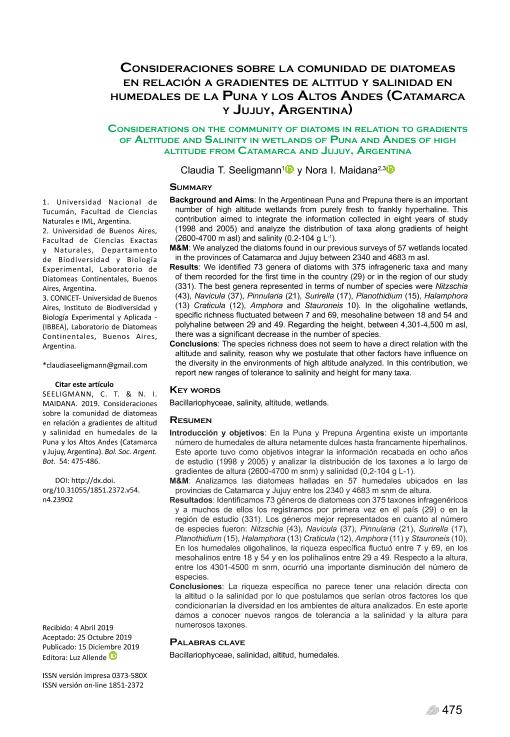Artículo
Introducción y objetivos: En la Puna y Prepuna Argentina existe un importante número de humedales de altura netamente dulces hasta francamente hiperhalinos. Este aporte tuvo como objetivos integrar la información recabada en ocho años de estudio (1998 y 2005) y analizar la distribución de los taxones a lo largo de gradientes de altura (2600-4700 m snm) y salinidad (0,2-104 g L-1). M&M: Analizamos las diatomeas halladas en 57 humedales ubicados en las provincias de Catamarca y Jujuy entre los 2340 y 4683 m snm de altura. Resultados: Identificamos 73 géneros de diatomeas con 375 taxones infragenéricos y a muchos de ellos los registramos por primera vez en el país (29) o en la región de estudio (331). Los géneros mejor representados en cuanto al número de especies fueron: Nitzschia (43), Navicula (37), Pinnularia (21), Surirella (17), Planothidium (15), Halamphora (13) Craticula (12), Amphora (11) y Stauroneis (10). En los humedales oligohalinos, la riqueza específica fluctuó entre 7 y 69, en los mesohalinos entre 18 y 54 y en los polihalinos entre 29 a 49. Respecto a la altura, entre los 4301-4500 m snm, ocurrió una importante disminución del número de especies. Conclusiones: La riqueza específica no parece tener una relación directa con la altitud o la salinidad por lo que postulamos que serían otros factores los que condicionarían la diversidad en los ambientes de altura analizados. En este aporte damos a conocer nuevos rangos de tolerancia a la salinidad y la altura para numerosos taxones. Background and Aims: In the Argentinean Puna and Prepuna there is an important number of high altitude wetlands from purely fresh to frankly hyperhaline. This contribution aimed to integrate the information collected in eight years of study (1998 and 2005) and analyze the distribution of taxa along gradients of height (2600-4700 m asl) and salinity (0.2-104 g L-1). M&M: We analyzed the diatoms found in our previous surveys of 57 wetlands located in the provinces of Catamarca and Jujuy between 2340 and 4683 m asl. Results: We identified 73 genera of diatoms with 375 infrageneric taxa and many of them recorded for the first time in the country (29) or in the region of our study (331). The best genera represented in terms of number of species were Nitzschia (43), Navicula (37), Pinnularia (21), Surirella(17), Planothidium (15), Halamphora (13) Craticula (12), Amphora and Stauroneis 10). In the oligohaline wetlands, specific richness fluctuated between 7 and 69, mesohaline between 18 and 54 and polyhaline between 29 and 49. Regarding the height, between 4,301-4,500 m asl, there was a significant decrease in the number of species. Conclusions: The species richness does not seem to have a direct relation with the altitude and salinity, reason why we postulate that other factors have influence on the diversity in the environments of high altitude analyzed. In this contribution, we report newranges of tolerance to salinity and height for many taxa.
Consideraciones sobre la comunidad de diatomeas en relación a gradientes de altitud y salinidad en humedales de la Puna y los Altos Andes (Catamarca y Jujuy, Argentina)
Título:
Considerations on the community of diatoms in relation to gradients of Altitude and Salinity in wetlands of Puna and Andes of high altitude from Catamarca and Jujuy, Argentina
Fecha de publicación:
12/2019
Editorial:
Sociedad Argentina de Botánica
Revista:
Boletín de la Sociedad Argentina de Botánica
ISSN:
0373-580X
e-ISSN:
1851-2372
Idioma:
Español
Tipo de recurso:
Artículo publicado
Clasificación temática:
Resumen
Palabras clave:
BACILLARIOPHYCEAE
,
SALINIDAD
,
ALTITUD
,
HUMEDALES
Archivos asociados
Licencia
Identificadores
Colecciones
Articulos(IBBEA)
Articulos de INSTITUTO DE BIODIVERSIDAD Y BIOLOGIA EXPERIMENTAL Y APLICADA
Articulos de INSTITUTO DE BIODIVERSIDAD Y BIOLOGIA EXPERIMENTAL Y APLICADA
Citación
Seeligmann, Claudia Teresa; Maidana, Nora Irene; Consideraciones sobre la comunidad de diatomeas en relación a gradientes de altitud y salinidad en humedales de la Puna y los Altos Andes (Catamarca y Jujuy, Argentina); Sociedad Argentina de Botánica; Boletín de la Sociedad Argentina de Botánica; 54; 4; 12-2019; 475-486
Compartir
Altmétricas




